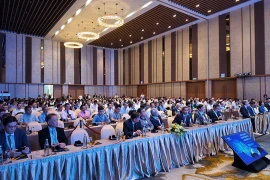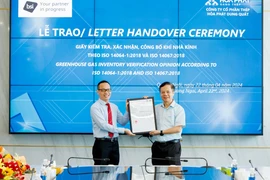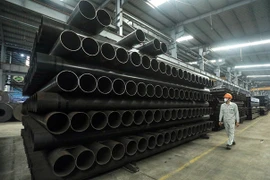Hanoi (VNA) - The steel industry has affirmed its position by reaching the Top 12 in the world in terms of crude steel production. Not only is the production output growing rapidly, but Vietnamese steel products are also gradually becoming more diverse, according to the Vietnam Steel Association (VSA).
VSA Chairman Nghiem Xuan Da said that since 2015, Vietnam's steel industry has developed into one of the leading manufacturers in ASEAN in terms of production and sale of finished steel products. In 2023, it also ranked 12th globally in crude steel production, with an output of 20 million tonnes.
Nguyen Van Sua, an industry insider, said that before 2000, total crude steel output was only about 100,000 tonnes per year, mainly serving domestic demand.
Entering the 2000s, the emergence of private enterprises such as Hoa Phat, Hoa Sen and Viet Duc, and joint ventures with the Vietnam Steel Corporation such as Vina Kyoei, SSSC and Vinausteel quickly created significant changes in the structure of the steel industry.
These enterprises considerably improved the manufacturing capacity and product quality, and diversified types in the market. At that time, Vietnam turned out 0.5 million tonnes of crude steel and 2 million tonnes of products each year.
In 2001, the VSA officially came into being, with the participation of large enterprises. The association plays an important role in promoting cooperation between businesses, improving competitiveness and boosting efforts towards sustainable development. Its establishment has created favourable conditions for Vietnamese steel enterprises to learn from international experience, apply new technology and expand export markets, Sua noted.
He added that in recent years, businesses have strongly invested in modern technology, improved product quality and expanded export markets. The maintenance of an annual output growth rate of 10-15% has demonstrated the industry's strength and development potential. Besides, great strides have been recorded in the manufacturing of high-quality steel to gradually replace imports.
Da said that the diversity of products has helped the industry supplement the missing product ranges, meet domestic demand and improve its position in Southeast Asia. Thanks to these efforts, Vietnam's steel sector has affirmed its increasingly important role in the world's steel industry.
Investment in large and modern steel projects has boosted the crude steel production capacity and attracted interest from key industries such as mechanical engineering, construction and defence. This not only helps Vietnam's steel industry improve its standing in the international market but also makes an important contribution to national industrialisation and modernisation, added Da./.
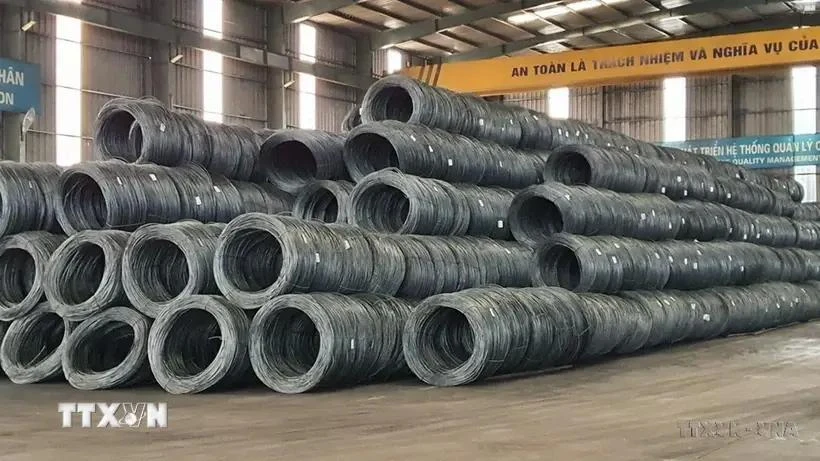
See more

US businesses affirm long-term commitment to Vietnam
During the meeting, US delegates expressed appreciation for the Vietnamese Government’s goodwill and for its efforts to maintain a favourable investment climate. They proposed Vietnam continue enhancing its business environment by addressing bottlenecks in administrative procedures, non-tariff barriers, taxation, and fees, while ensuring infrastructure conditions, transparency, and rules of origin

VinFast to establish over 100 service centres in Philippines
Four Philippine partners will operate official VinFast service centres offering maintenance, repairs, and customer care for EVs in line with the company’s global standards.

Vietnam, US push for balanced trade
Imports from the US are predicted to rise sharply in the coming months as large Vietnamese enterprises are accelerating purchases from the North American market in efforts to balance bilateral trade.

Vietnamese enterprises seek stronger partnerships with US at investment summit
The visit and a series of bilateral meetings with US partners underscore Vietnam’s strong commitment to deepening trade and investment ties with the US, a comprehensive strategic partner and the world's leading economy.

Banks cut staff, transaction branches amid digital promotion
VietinBank will be the first bank in the country’s group of four largest State-owned commercial banks (Big4) to cut the number of its transaction offices. According to a plan released at VietinBank’s annual general meeting of shareholders (AGM) recently, the bank is expected to cut hundreds of transaction points to streamline the system in 2025.

Binh Duong develops new 16-hectare centralised IT zone
The establishment of a new centralised information technology (IT) zone in Binh Duong Province marks a significant step in the locality’s digital transformation strategy and its ambition to build a knowledge-based economy.

VinFast officially unveils new compact electric cargo van
Priced at 285 million VND (about 10,980 USD), the first VinFast EC Van units are expected to be delivered to customers starting this November.
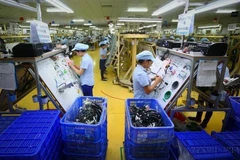
PM orders overhaul to improve business environment
The dispatch further highlights the need for comprehensive measures to enhance governance capacity, accelerate socio-economic progress, and improve the investment and business landscape with a clear emphasis on sustainable development and environmental stewardship.
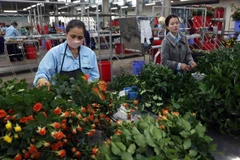
Vietnam's flower export turnover surpasses 100 million USD mark
The total area dedicated to growing flowers and ornamental plants has reached nearly 45,000 ha, an eightfold increase compared to the year 2000.
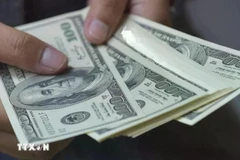
Reference exchange rate up 28 VND on May 13
The State Bank of Vietnam set the daily reference exchange rate for the US dollar at 24,973 VND/USD on May 13, up 28 VND from the previous day.

Honda’s motorcycle, auto sales surge in Vietnam
Honda Vietnam reported robust sales growth in April across both its motorcycle and automobile segments, with year-on-year increases of 6.9% and 18.9%, respectively.

Transport, industrial development essential for Thai Binh to be wealthier: PM
The groundbreaking ceremonies of the Ninh Binh–Hai Phong Expressway Project’s section and the Hung Phu Industrial Park in Thai Binh affirm the government’s determination to create an attractive investment and business environment for both domestic and foreign investors; foster provincial and regional connectivity, generate momentum and open new development space for Thai Binh and the northern coastal region.
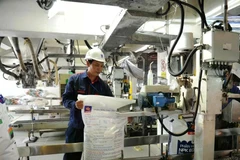
Ca Mau fertiliser gains top-level export certification from Australia
PVCFC was the only fertiliser company in Vietnam to achieve "Level Two System Status" in Australia as of 2024 and has since advanced to Level One by 2025.
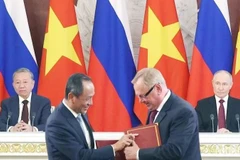
Vietnam Airlines signs MoU on cooperation with Russia's VTB Bank
The MoU also demonstrates Vietnam Airlines' efforts to expand its partnership in the international market, while affirming its pioneering role in connecting Vietnam with the world, contributing to the sustainable development of Vietnam-Russia relations in the new period.
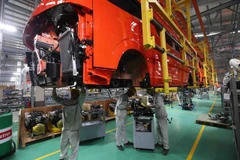
Vietnam eyes 8% growth in 2025 through strategic reforms
With decisive policy actions, proactive diplomacy and strategic reform priorities, the country is now aiming for an ambitious GDP growth target of 8% or more this year - a goal lawmakers and experts believe is within reach, provided key breakthroughs are implemented effectively.
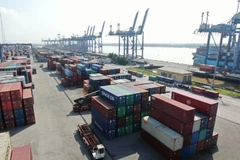
Vietnam enjoys positive export growth in new markets
According to the Ministry of Industry and Trade, by the end of April, Vietnam’s total export turnover reached 140.34 billion USD, an increase of 13% compared to the same period in 2024.
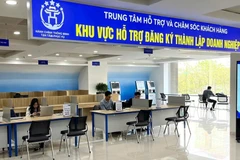
Hanoi targets 30,000 new enterprises in 2025
By the end of 2024, the number of registered enterprises in the capital city reached over 400,000, with about 220,000 operating. Notably, more than 98% of the operating firms are SMEs which create jobs for 55.1% of the local workforce and contribute over 40% of the city’s gross domestic product (GDP).
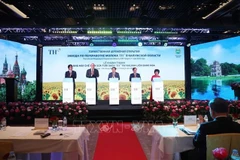
TH Group inaugurates large-scale dairy processing plant in Russia
The plant has a total capacity of 1,000 tonnes per day, with the first phase producing 500 tonnes daily. All milk used at the plant is sourced from TH’s high-tech farms in the Moscow and Kaluga oblasts. TH milk boasts a high nutritional profile, with a fat content of 4.0% and protein at 3.2% — among the highest quality levels in Russia.

Reference exchange rate down 6 VND at week’s beginning
The State Bank of Vietnam set the daily reference exchange rate for the US dollar at 24,945 VND/USD on May 12, down 6 VND from the last work day of the previous week.

Vietnamese enterprises urged to adopt strategic measures amid US tariff threat
Amid unpredictable fluctuations in US tariff policies, Vietnamese businesses must take a proactive and strategic approach to sustain their exports to this key market, experts emphasised at a workshop held in Ho Chi Minh City on May 9.
